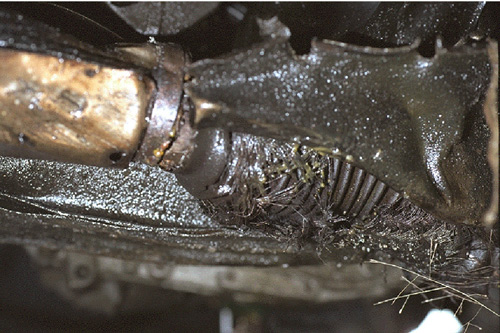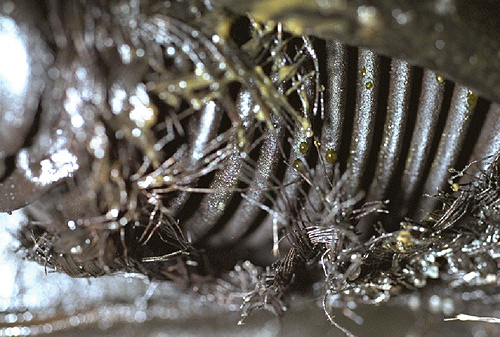1991 Mitsubishi Eclipse: Case Study
Ignition and Propagation
1991 Mitsubishi Eclipse: Case Study
Ignition and Propagation
Ignition
|
 Exhaust pipe with torn braided wire cover. |
The exhaust pipe in the area adjacent to the oil pan was partially enclosed by a metal shield and braided wire covering. The pipe geometry under the braided wire cover was of convoluted/corrugated pipe design. Entrapment of the oil in exhaust pipe covers may have facilitated autoignition of oil vapor on the hot pipe surface. The shielded exhaust pipe during 70-mph operation was likely to have been hot enough to ignite engine oil.
The only other potential ignition source for the oil vapor was mechanical spark resulting from interaction between the culvert and undercarriage components. However, a hot surface provides a more continuous ignition source for combustible mixtures. The mechanical sparks due to impact were instantaneous; if a combustible mixture was not present at that precise moment, no ignition would have occurred. Therefore, mechanical spark ignition was considered less likely.
Propagation
|
 Close up of area on convoluted/corrugated exhaust pipe blackened by fire. |
Post fire damage on the vehicle was minimal. From witness accounts and inspection of the vehicle, the fire was confined to the area of the exhaust system adjacent to the oil pan. No other heat damage was evident on the vehicle. After the vehicle came to rest, a passing motorist stopped and informed the driver (while he was still in the vehicle) that it was on fire. The fire was promptly extinguished by a passer-by.
Because the vehicle came to rest on its roof, the exhaust system was a high point on the vehicle, with no consumable materials above the flame. Therefore, the fire was sustained by the oil vapor generated by the exhaust pipes, and did not propagate prior to being extinguished. It is unknown if the fire would have propagated or simply used the available fuel supply (oil) and self extinguished. Engine oil appears to have been the only fuel available in this incident. Evidence indicates that the majority of oil was spilled while the vehicle was on its wheels and very little oil was found splattered in the engine compartment that would have facilitated propagation of the fire to other areas of the engine compartment. Even the undercarriage of the vehicle aft of the oil pan exhibited little evidence of oil spray.